1998 PONTIAC BONNEVILLE brake
[x] Cancel search: brakePage 88 of 395
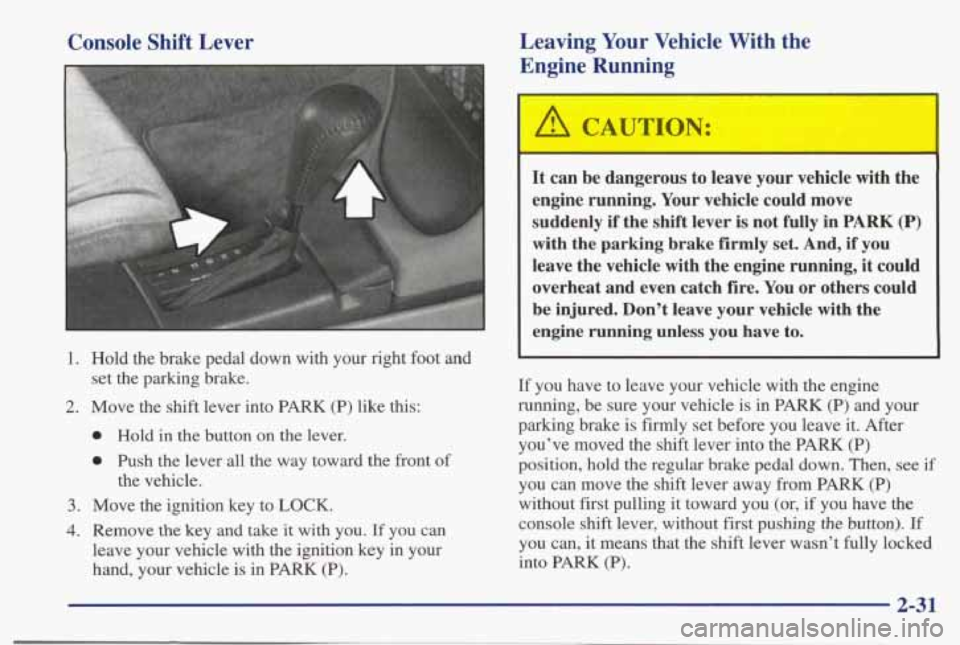
Console Shift Lever Leaving Your Vehicle With
the
Engine Running
1. Hold the brake pedal down with your right foot and
2. Move the shift lever into PARK (P) like this:
set the parking brake.
,I
0 Hold in the button on the lever.
0 Push the lever all the way toward the front of
the vehicle.
3. Move the ignition key to LOCK.
4. Remove the key and take it with you. If you can
leave your vehicle with the ignition key in your
hand, your vehicle is in PARK
(P).
A CAUTION:
It can be dangerous to leave your vehicle with the
engine running. Your vehicle could move
suddenly
if the shift lever is not fully in PARK (P)
with the parking brake firmly set. And, if you
leave the vehicle with the engine running,
it could
overheat and even catch fire. You or others could
be injured. Don’t leave your vehicle with the
engine running unless you have to.
If you have to leave your vehicle with the engine
running, be sure your vehicle is in PARK (P) and your
parking brake is firmly set before you leave it. After you’ve moved the shift lever into the PARK (P)
position, hold the regular brake pedal down. Then,
see if
you can move the shift lever away from PARK (P)
without first pulling it toward you (or,
if you have the
console shift lever, without first pushing
the button). If
you can, it means that the shift lever wasn’t fully locked
into PARK (P).
2-31
Page 89 of 395
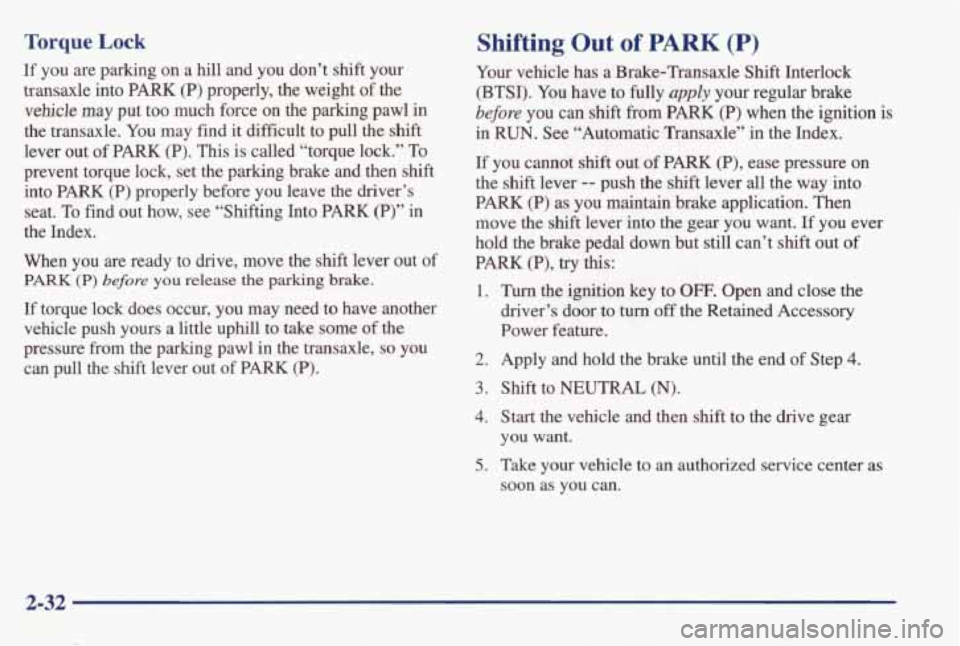
Torque Lock
If you are parking on a hill and you don’t shift your
transaxle into
PARK (P) properly, the weight of the
vehicle may put too much force on the parking pawl in
the transaxle. You may find it difficult to pull the
shift
lever out of PARK (P). This is called “torque lock.” To
prevent torque lock, set the parking brake and then shift
into
PARK (P) properly before you leave the driver’s
seat.
To find out how, see “Shifting Into PARK (P)” in
the Index.
When you are ready to drive, move the shift lever out of
PARK (P) before you release the parking brake.
If torque lock does occur, you may need to have another
vehicle push yours a little uphill to take some of the
pressure from the parking pawl in the transaxle,
so you
can pull the shift lever out of PARK
(P).
Shifting Out of PARK (P)
Your vehicle has a Brake-Transaxle Shift Interlock
(BTSI). You have to fully apply your regular brake
before you can shift from PARK (P) when the ignition is
in
RUN. See “Automatic Transaxle” in the Index.
If you cannot
shift out of PARK (P), ease pressure on
the
shift lever -- push the shift lever all the way into
PARK (P) as you maintain brake application. Then
move
the shift lever into the gear you want. If you ever
hold the brake pedal down but still can’t shift out of
PARK (P), try this:
1. Turn the ignition key to OFF. Open and close the
driver’s door
to turn off the Retained Accessory
Power feature.
2. Apply and hold the brake until the end of Step 4.
3. Shift to NEUTRAL (N).
4. Start the vehicle and then shift to the drive gear
you want.
5. Take your vehicle to an authorized service center as
soon as you can.
2-32
Page 91 of 395
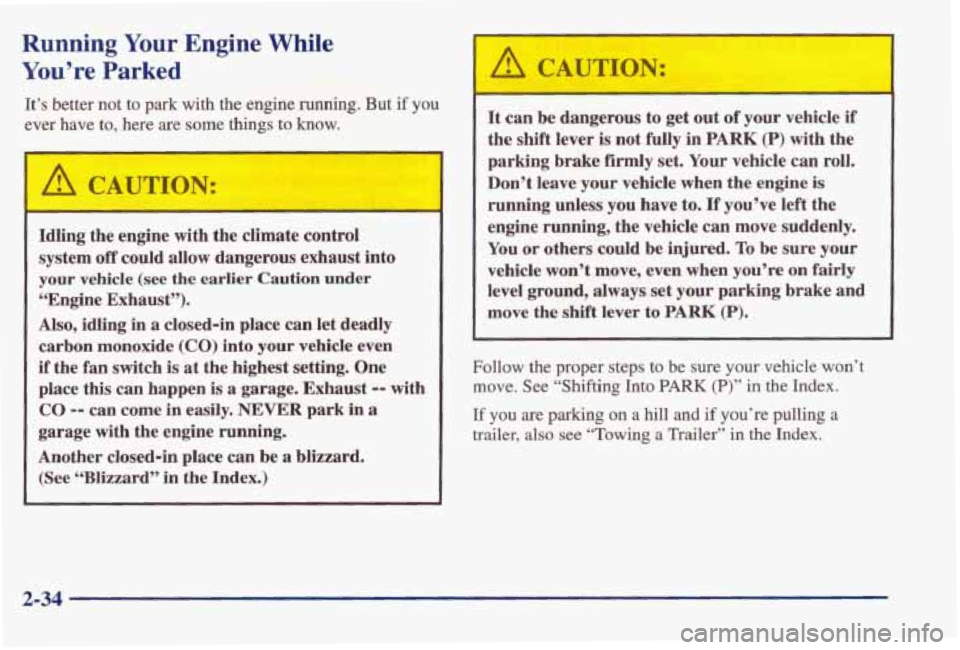
Running Your Engine While
You’re Parked
It’s better not to park with the engine running. But if you
ever have to, here are some things to know.
&A CAUTION:
Idling the engine with the climate control
system
off could allow dangerous exhaust into
your vehicle
(see the earlier Caution under
“Engine Exhaust”).
Also, idling in a closed-in place can let deadly
carbon monoxide
(CO) into your vehicle even
if the fan switch is at the highest setting. One
place this can happen is a garage. Exhaust
-- with
CO -- can come in easily. NEVER park in a
garage with the engine running.
Another closed-in place can be
a blizzard.
(See
“Blizzard” in the Index.)
-
1
I
It can be dangerous to get out of your vehicle if
the shift lever is not
fully in PARK (P) with the
parking brake
firmly set. Your vehicle can roll.
Don’t leave your vehicle when the engine
is
running unless you have to. If you’ve left the
engine running, the vehicle can move suddenly.
You or others could be injured.
To be sure your
vehicle won’t move, even when you’re
on fairly
level ground, always set your parking brake and
move the shift lever
to PARK (P).
Follow the proper steps to be sure your vehicle won’t
move. See “Shifting Into
PARK (P)” in the Index.
If you are parking on a hill and if you’re pulling a
trailer, also see “Towing a Trailer” in the Index.
2-34
Page 97 of 395
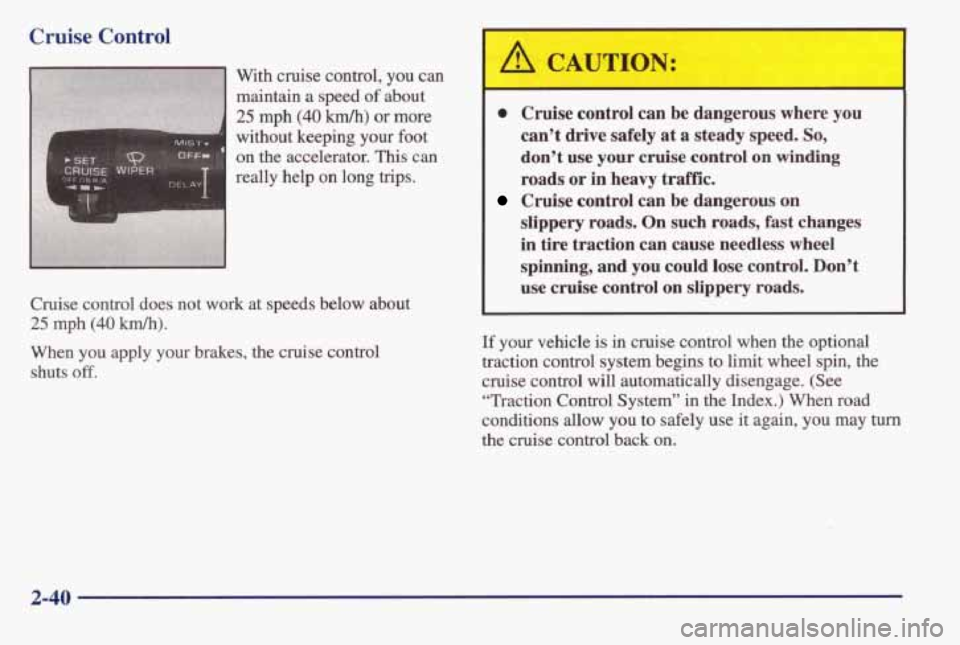
Cruise Control
on the accelerator. This can
really help
on long trips.
Cruise control
does not work at speeds below about
25 mph (40 km/h).
When you apply your brakes, the cruise control
shuts off.
I A CAUTION:
0 Cruise control can be dangerous where you
can’t drive safely at a steady speed.
So,
don’t use your cruise control on winding
roads or in heavy traffic.
slippery roads.
On such roads, fast changes
in tire traction can cause needless wheel
spinning,
and you could lose control. Don’t
use cruise control on slippery roads.
Cruise control can be dangerous on
If your vehicle is in cruise control when the optional
traction control system begins to limit wheel spin, the
cruise control will automatically disengage. (See “Traction Control System” in the Index.) When road
conditions allow
you to safely use it again, you may turn
the cruise control back on.
2-40
Page 98 of 395
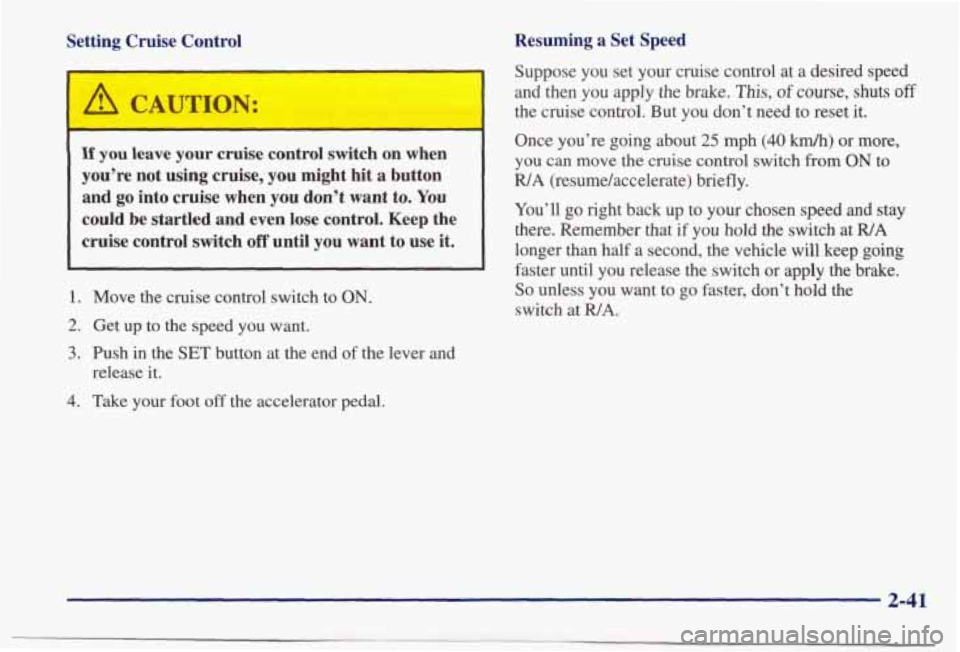
Setting Cruise Control
‘
A CAUTION:
If you leave your cruise control switch on when
you’re not using cruise, you might hit a button
and go into cruise when you don’t want to. You
could be startled and even lose control.
Keep the
cruise control switch
off until you want to use it.
1. Move the cruise control switch to ON.
2. Get up to the speed you want.
3. Push in the SET button at the end of the lever and
release
it.
4. Take your foot off the accelerator pedal.
Resuming a Set Speed
Suppose you set your cruise control at a desired speed
and then you apply the brake.
This, of course, shuts off
the cruise control. But you don’t need to reset it.
Once you’re going about
25 mph (40 km/h) or more,
you can move the cruise control switch from
ON to
R/A (resume/accelerate) briefly.
You’ll go right back up to your chosen speed and stay there. Remember that
if you hold the switch at WA
longer than half a second, the vehicle will keep going
faster until you release the switch or apply the brake.
So unless you want to go faster, don’t hold the
switch at
WA.
2-41
Page 99 of 395
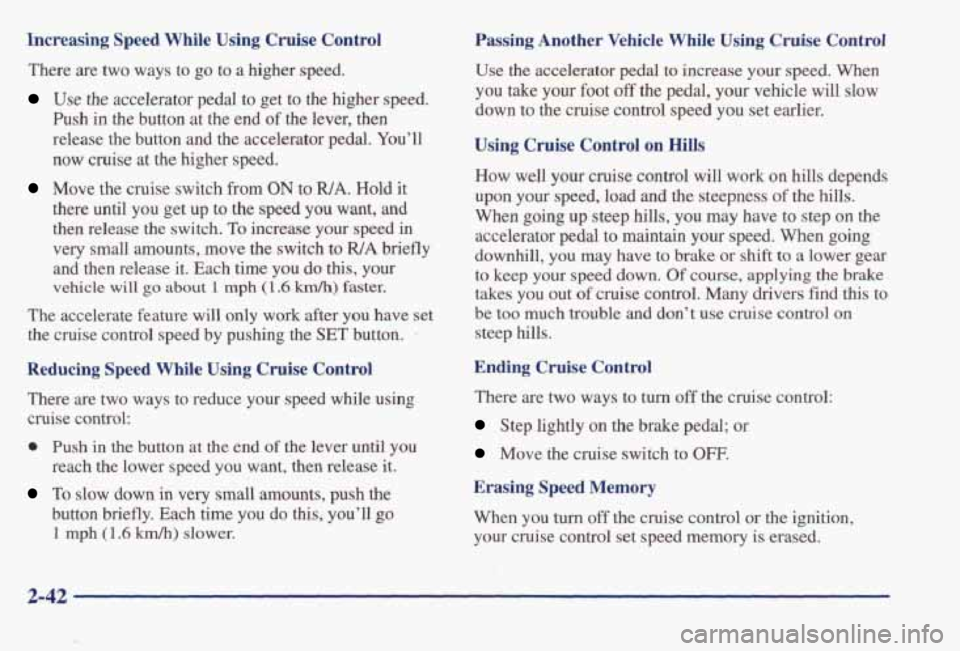
Increasing Speed While Using Cruise Control
There are two ways to go to a higher speed.
Use the accelerator pedal to get to the higher speed.
Push in the button at the end
of the lever, then
release
the button and the accelerator pedal. You’ll
now
cruise at the higher speed.
Move the cruise switch from ON to WA. Hold it
there until you get up to the speed
you want, and
then release the switch.
To increase your speed in
very small amounts, move the switch to
RfA briefly
and then release it. Each time
you do this, your
vehicle will go about 1 mph (1.6 km/h) faster.
The accelerate feature will only work after you have set
the cruise control speed by pushing the
SET button. 0
Reducing Speed While Using Cruise Control
There are two ways to reduce your speed while using
cruise control:
0 Push in the button at the end of the lever until you
reach the lower speed
you want, then release it.
To slow down in very small amounts, push the
button briefly. Each time you do
this, you’ll go
1 mph (1.6 kmk) slower.
Passing Another Vehicle While Using Cruise Control
Use the accelerator pedal to increase your speed. When
you take your foot off the pedal, your vehicle will slow
down to the cruise control speed you set earlier.
Using Cruise Control on Hills
How well your cruise control will work on hills depends
upon your speed, load and the steepness
of the hills.
When going
up steep hills, you may have to step on the
accelerator
pedal to maintain your speed. When going
downhill, you may have to brake or
shift to a lower gear
to keep your speed down.
Of course, applying the brake
takes you out
of cruise control. Many drivers find this to
be too much trouble and don’t use cruise control on
steep hills.
Ending Cruise Control
There are two ways to turn off the cruise control:
Step lightly on the brake pedal; or
Move the cruise switch to OFF.
Erasing Speed Memory
When you turn off the cruise control or the ignition,
your cruise control set speed memory
is erased.
2-42
Page 122 of 395
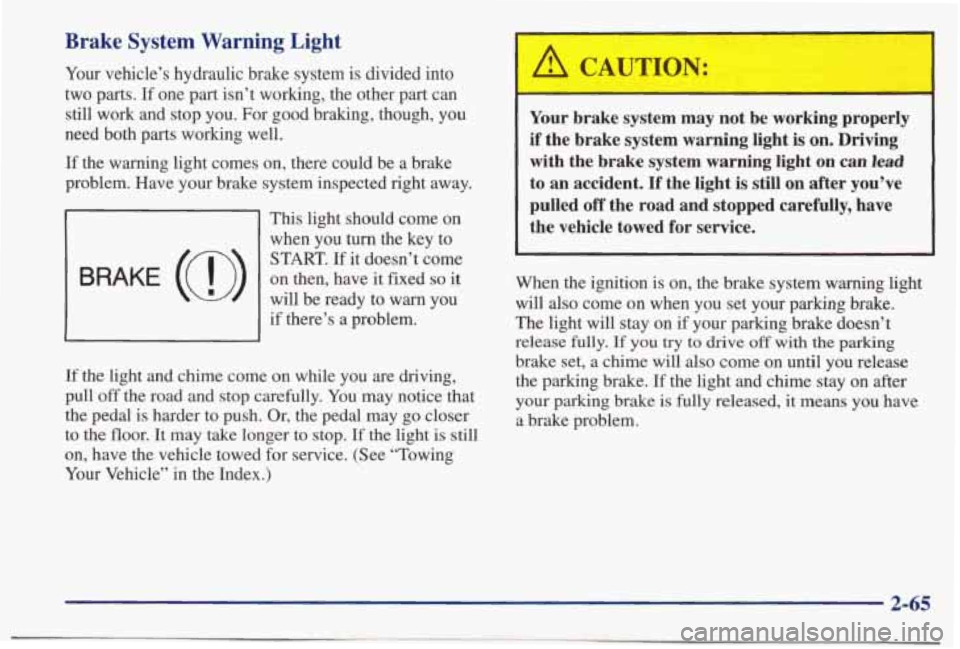
Brake System Warning Light
Your vehicle’s hydraulic brake system is divided into
two parts. If one part isn’t working, the other part can still work and stop you. For good braking, though, you
need both parts working well.
If the warning light comes on, there could be a brake
problem. Have your brake system inspected right away.
BRAKE (0)
This light should come on
when you turn the key to
START. If it doesn’t come
on then, have it fixed so it
will be ready to warn you
if there’s a problem.
If the light and chime come on while you are driving,
pull
off the road and stop carefully. You may notice that
the pedal is harder to push. Or, the pedal may go closer
to the floor. It may take longer to stop.
If the light is still
on, have the vehicle towed for service. (See “Towing
Your Vehicle” in the Index.)
A CAUTION:
Your brake system may not be working properly
if the brake system warning light is on.
Driving
with the brake system warning light on can lead
to an accident. If the light is still on after you’ve
pulled
off the road and stopped carefully, have
the vehicle towed for service.
When the ignition is on, the brake system warning light
will also come on when you set your parking brake.
The light will stay on if your parking brake doesn’t
release
fully. If you try to drive off with the parking
brake set, a chime will also come on until you release
the parking brake. If the light and chime stay on after
your parking brake is fully released. it means you have
a brake problem.
2-65
Page 123 of 395
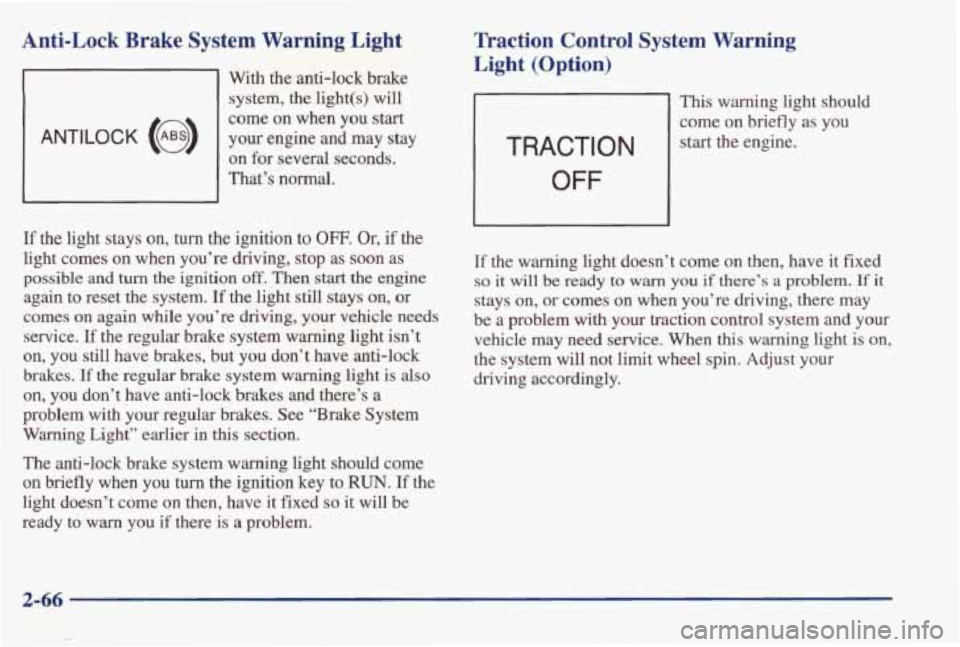
Anti-Lock Brake System Warning Light
ANTILOCK (@)
With the anti-lock brake system,
the light(s) will
come on when
you start
your engine and may stay
on for several seconds.
That’s normal.
llraction Control System Warning
Light (Option)
TRACTION
OFF
This warning light should
come on briefly as you
start the engine.
If the light stays on, turn the ignition to OFF. Or, if the
light comes on when you’re driving, stop as soon as
possible
and turn the ignition off. Then start the engine
again to reset the system.
If the light still stays on, or
comes on again while you’re driving, your vehicle needs
service. If the regular brake system warning light isn’t
on, you still have brakes, but you don’t have anti-lock
brakes.
If the regular brake system warning light is also
on, you don’t have anti-lock brakes and there’s a
problem with your regular brakes. See “Brake System
Warning Light” earlier in
this section.
If the warning light doesn’t come on then, have it fixed
so it will be ready to warn you if there’s a problem. If it
stays on, or comes on when you’re driving, there may
be a problem with your traction control system and your
vehicle may need service. When this warning light is on,
the system will not limit wheel spin. Adjust your
driving accordingly.
The anti-lock brake system warning light should come
on briefly when you turn the ignition key to RUN. If the
light doesn’t come on then, have it fixed
so it will be
ready to
warn you if there is a problem.